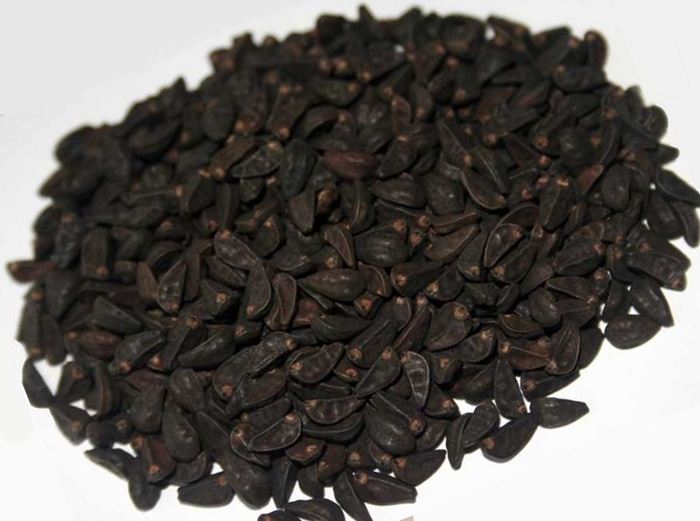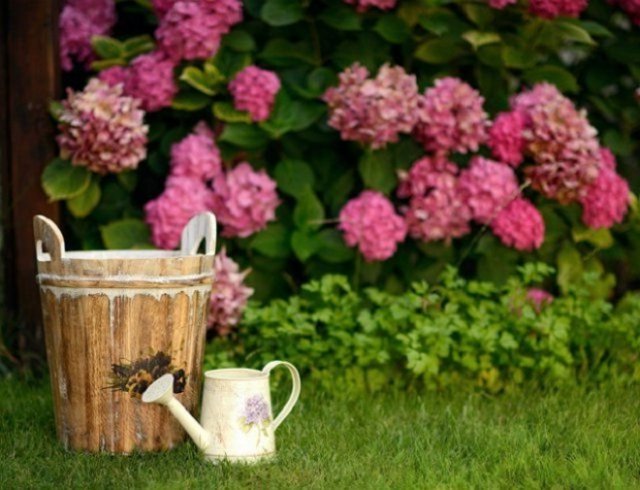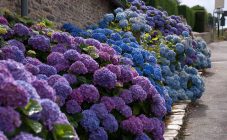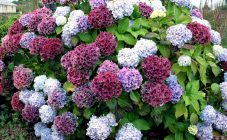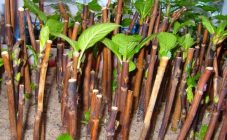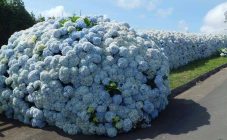Content:
Many gardeners love hydrangea for its spectacular inflorescences that look like bright hats. This is a rather demanding plant in terms of growth and care, but still flower growers throughout Russia dream of growing it in their garden. The shrub can be propagated both vegetatively and by seeds.
Description of culture
Hydrangea (Hydrángea) is a tree-like shrub from the Hortensia family. Introduced to Europe at the beginning of the 14th century from East Asia for the wealthy strata of the population. In the wild in Russia, it is found in the Far East. Today there are about 600 varieties of garden hydrangea. Basically, shrubs reach heights of 1 m or more. The bush is rounded, the shoots are thin, slightly pubescent. The leaves are large, up to 20 cm long, the location on the shoot is opposite. Flowering lasts from July to autumn. Paniculate inflorescences, beautiful spherical shape.
Most varieties have two types of flowers:
- Fertile. They are small, located in the center, form pollen and fruits.
- Sterile. Large, attention-grabbing, unable to reproduce.
There are varieties that have only sterile flowers. They do not produce seeds and reproduce only vegetatively. Some varieties need to be pruned annually, as the bushes are so elongated that they can break under the weight of the inflorescences. This extraordinary plant has varieties whose colors depend on the acidity of the soil: the higher the pH, the more intense blue the flowers will be. If you water the soil with a weak solution of potassium permanganate, then the flowers will acquire a pink tint for several days.
Hydrangea from seed
Planting with garden hydrangea seeds is done in February. The light for seedlings should be bright, but direct sunlight should not hit the plant. With a lack of lighting, the seedlings will stretch out and weaken. Growing hydrangea seedlings near heating devices is not allowed. The plant is afraid of drafts. The optimum temperature is + 14-20 gr., Without sudden changes. You need to feed seedlings twice a month. To do this, you can use any complex fertilizer for flowers or a special complex for hydrangeas.
How to grow a hydrangea from seeds at home, step by step instructions:
- First, they need to be germinated over a few days in a damp cloth or cotton wool.
- Prepare a nutritious soil. To do this, you need to take 4 parts of leafy land, 2 parts of peat, 1 part of sand.
- Fill containers with the resulting substrate.
- Spread the hydrangea seeds over the surface and sprinkle with a layer of sand.
- From above it is necessary to cover the containers with glass or transparent film to create a favorable climate.
- Crops are periodically moistened from a spray bottle. Too high humidity will lead to rotting seeds, and if there is a lack of water, they will simply dry out.
- Also, the glass should be removed briefly daily to ensure oxygen supply.
- The first shoots can be expected in 2-3 weeks. As soon as the seeds germinate, the glass is removed.
- Hydrangea is a moisture-loving plant, so you need to water it daily.
- The air in the room must be humidified, for this you need to irrigate the seedlings from a spray bottle several times a day. Or install a humidifier in the room.
- As soon as the sprouts have a second true leaf, they are dived into other containers. The composition of the soil is the same.
- When the seedlings grow up, they are planted one at a time. It is undesirable to use too large containers, enough pots with a diameter of 6-7 cm.
- A garden hydrangea, planted with seeds, is transplanted to a permanent place two years after germination.
Planting seedlings
The shrub needs diffused light, the direct scorching sun will not allow hydrangeas to bloom to the full. A slightly acidic nutrient soil is also required. Despite the fact that this is a moisture-loving plant, it does not tolerate stagnant water, so the soil should be light and permeable. It is impossible to introduce lime or ash for planting, as this will lead to neutralization and diseases of the flower. If the soil is alkaline, it needs to be acidified. For this, moor peat is added to it, peat, sawdust or needles are used for mulch.
In addition, the following fertilizers acidify the soil:
- ammonium sulfate;
- potassium sulfate;
- inkstone.
You need to plant bushes in the spring. Before planting, the soil should be dug up, humus and superphosphate should be added to it. Dig planting holes 50x50 cm, at a distance of at least 1 meter, pour small stones and sand on the bottom.
The soil must be prepared separately: mix black soil, sand and peat. Place the seedling in the hole so that the root collar is at soil level. The root system of the hydrangea is quite branched, you need to carefully straighten the roots and cover with the resulting mixture. The soil must be trampled down, the seedling must be watered abundantly. Water should saturate the soil to a depth where the roots are located, that is, by 30-40 cm. You can make a roller of earth around the trunk circle and gradually pour in water (at least a bucket under the bush). Be sure to mulch the plantings with peat chips, wood chips or bark, with a layer of up to 10 cm.
Care
The first feeding is applied in the spring, before the beginning of the growing season, the next one - during the period of bud formation (in the third decade of May - early June). You can use a solution of mullein or chicken droppings (for 1 part of manure 10 parts of water). When the hydrangea blooms, it needs to be watered with a fertilizer solution twice a month. The main elements for the plant are superphosphate (20 g), potassium nitrate (10 g) and urea. At the end of July, feeding is stopped so that the green shoots have time to woody by winter. In the fall, before stable frosts, they are fed with superphosphate.
Watering is required constant, the soil around the seedling should always be moist. In order for oxygen to reach the roots, you need to periodically loosen the ground. Once a month, you should water the hydrangea with a weak solution of potassium permanganate to prevent the development of fungal diseases.
Before the onset of constant frosts, the bushes are watered abundantly. For the winter, young bushes are hidden from frost with covering material. In the spring it is removed when the threat of recurrent frosts has passed. Hydrangea quickly recovers after frost damage. A three-year-old plant can begin to be pruned: shape into a ball and remove dried shoots. In open ground conditions, hydrangea begins to bloom at the age of five.
Hydrangea seed selection
It is believed that seeds from the eastern countries, where the hydrangea come from (China and Japan), germinate best. Cheap seeds can be found in online stores that work directly with Chinese suppliers. The parcel is sent by post cash on delivery. However, consumer reviews suggest the opposite: it is better to trust Russian producers, despite the fact that seeds may cost a little more.
To determine a quality seed, you need to carefully look for damage. It should be intact, without dents. What hydrangea seeds look like: they are small, oblong, dark brown. If they are of a different color, they may be damp. You can collect the seeds yourself. They are formed only on fertile (small, nondescript) flowers. Bright large flowers serve to attract insects, they do not form pollen.
Other ways to breed hydrangeas
Growing hydrangea from seeds is a laborious and time consuming way. It suits those who have a serious interest in the matter and enough patience.
For faster and easier reproduction, there are vegetative methods:
- The easiest way to propagate hydrangea is by green cuttings, the percentage of their rooting is close to 100. To do this, in April-June, you need to choose annual shoots from the crown, cut cuttings from them, 10-12 cm long with 2-3 pairs of leaves. The cut is made at right angles. The leaves from the bottom must be removed, treated with root growth stimulants. When planting, you need to deepen the lower pair of buds to the middle of the internode. Cuttings take root on average 20-30 days. All this time, you need to maintain sufficient humidity. It is better to grow a seedling in a greenhouse with fertile soil or cover the planting with plastic bottles. The next year, plant the bushes in a permanent place.
- You can divide an adult bush in the spring. To do this, you need to dig it up, divide it with a pruner or a sharp shovel into several parts so that each one has several roots and shoots. The resulting cuttings are planted in a permanent place in fertile soil with an interval of 1 m. Usually, the divided plants take root well.
- Hydrangea is also propagated by layering. To do this, in the spring or autumn, choose a healthy bush, bent annual shoots to the ground, pin and dig in 2-3 cm.A top about 20 cm should remain on the surface.Periodically, you need to add soil and regularly water the layers and the bush. After a year, the shoot should take root. Then it is carefully separated from the mother bush with pruning shears and planted in the beds for growing. After another year, you can plant it in a permanent place. Young bushes will begin to bloom in the 4th year of life.
Growing a hydrangea is not an easy task in floriculture. But there is nothing supernatural either. You just need to plant it in a place without drafts, on moderately acidic soil, regularly water, fertilize and prune. You also need a lot of patience and love for flowering plants. With the right care, hydrangea will grow healthy, lush and regal.

